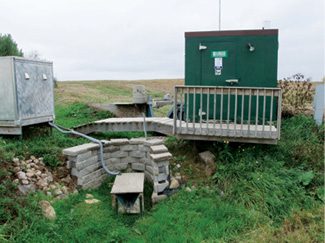The Great Lakes Restoration Initiative (GLRI) has a primary goal of improving water quality by concentrating conservation practices in areas around the Great Lakes known to have water-quality issues.
In the geographical area of watersheds that ultimately enter Lake Michigan’s Green Bay, this includes capturing agricultural runoff data for sediments and phosphorus.
The Lower Fox River Watershed, which is situated south of Green Bay, is home to a network of demonstration farms involved in supplying this critical data.
The network’s focus on soil health improvement through the use of cover crops and other conservation practices has led Greenleaf, Wis., dairy farmer Dan Brick to embrace edge-of-field monitoring on one of his sloping fields.
The station on his 10-acre field monitored by the U.S. Geological Service has operated for 4 years. The first 3 years were used to establish a baseline for data as the corn-on-corn field moved from conventional tillage to 100% no-till and cover crops.
“We can see that a cover crop drastically reduces sediment loss from the surface water,” Brick says. “And we know that we have nitrogen (N) losses out of the tiles at certain peaks throughout the year. Our goal with cover crops is to be able to retain a lot of that N before it goes out through the tile.”
After the field’s first no-till growing season in 2016, the field was seeded with triticale. In order to maintain consistency in monitoring results, the test field’s cover crops will remain either triticale or winter rye.
“By keeping this field’s management similar year after year, with the only changes being that we now implemented no-till with cover crops, we can attribute any reductions in readings to those two practices,” says Barry Bobolz, area GLRI coordinator with the NRCS.
Runoff water from Brick’s field — both surface and drainage tile water — is analyzed for suspended sediment, chloride, nitrate+nitrite, total Kjeldahl nitrogen, ammonium, orthophosphate and total phosphorus.
“What’s particularly important about this data is that it gives us a real-time, real-life assessment of what the conservation practices on this farm are doing to address soil and nutrient losses,” says Bobolz.
Brick adds, “It makes me feel better when we come up with this data, that all my hard work and efforts are paying off, and what no-till and applying cover crops will do.”
Related Content
No-Till, Cover Crops Improve Feed Quality, Limit Erosion and Build Soil Health
Reducing sediment and phosphorus runoff, improving soil health and reducing operational risk are goals for no-till dairy farmer Dan Brick.





Post a comment
Report Abusive Comment